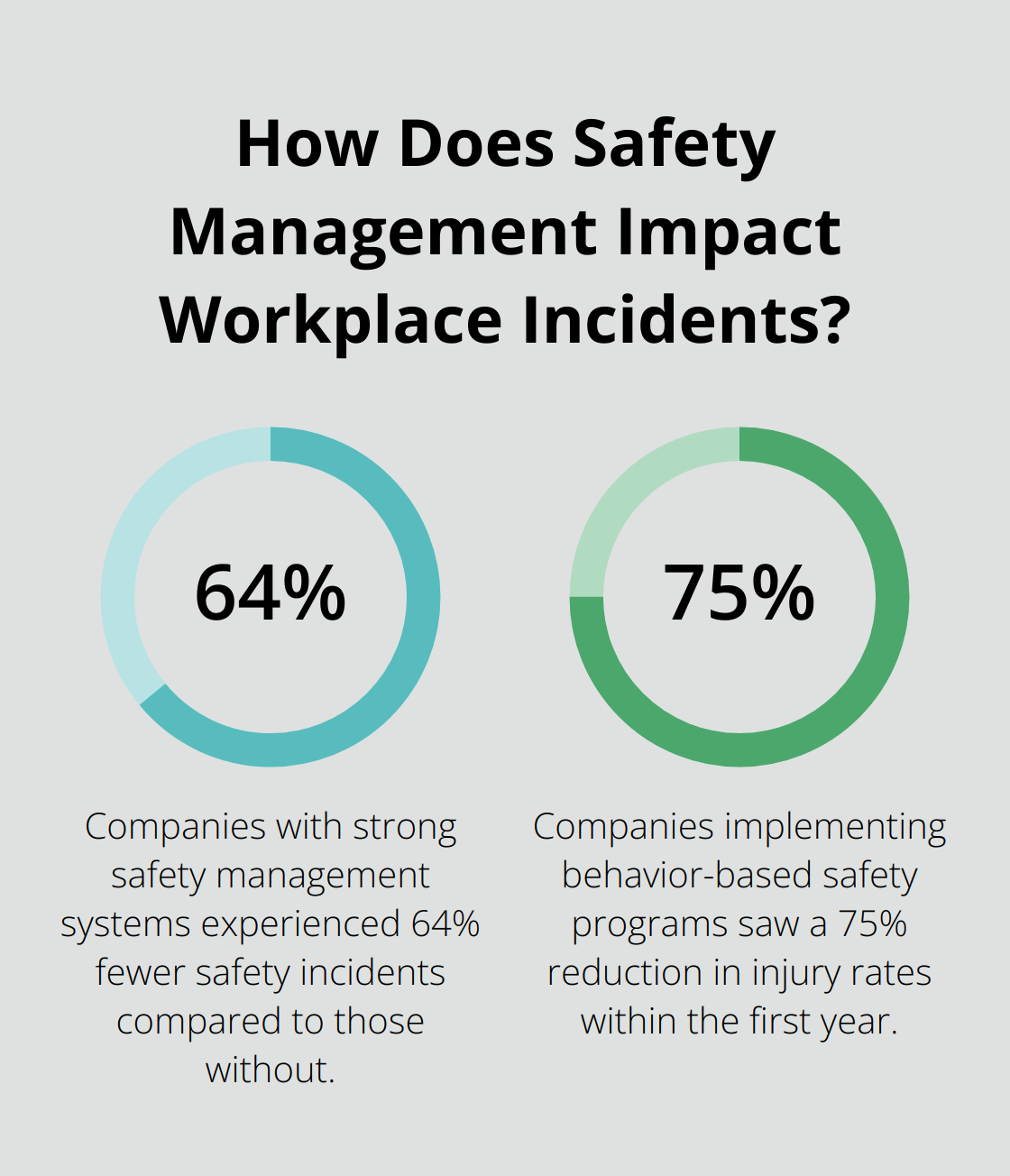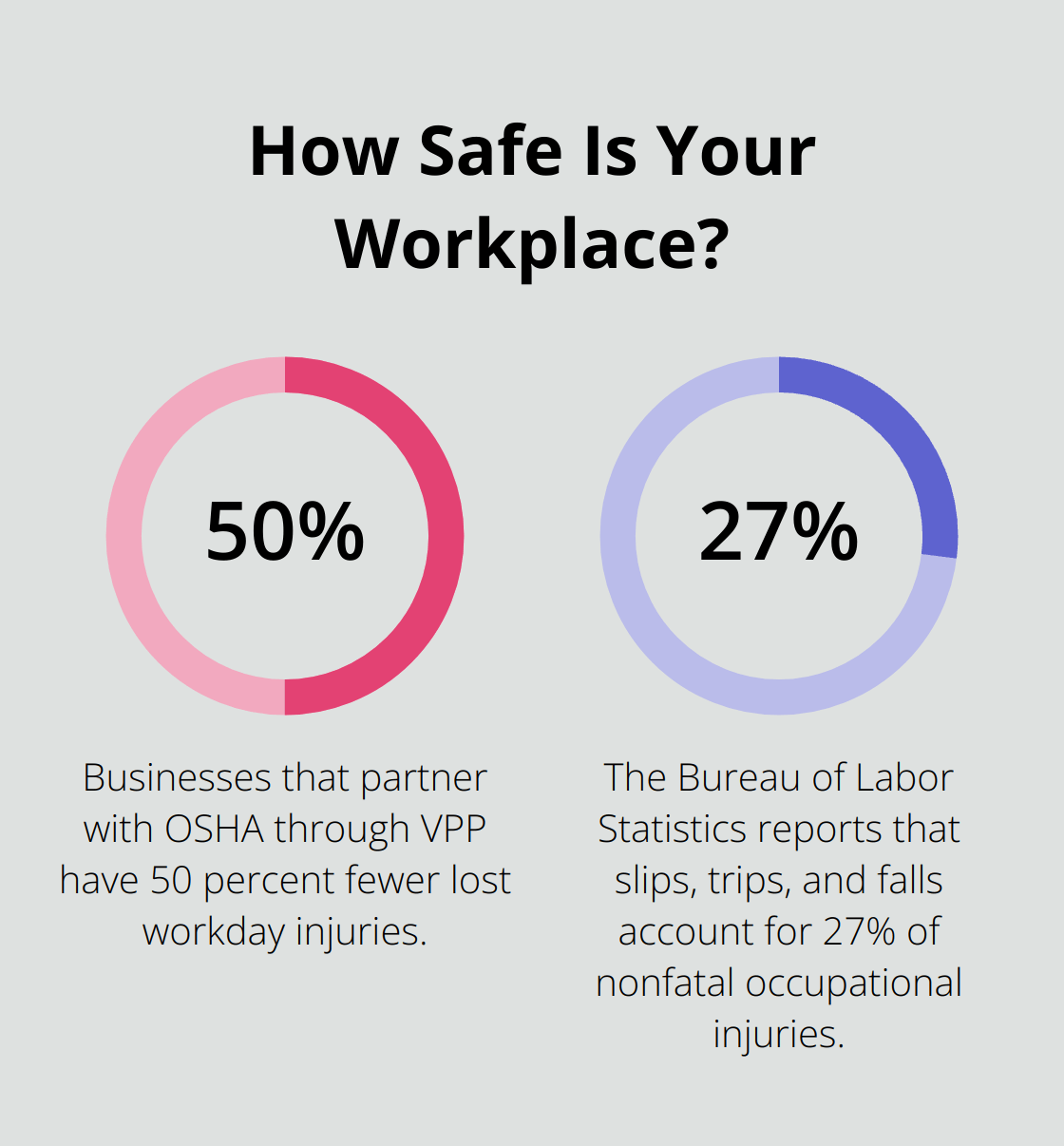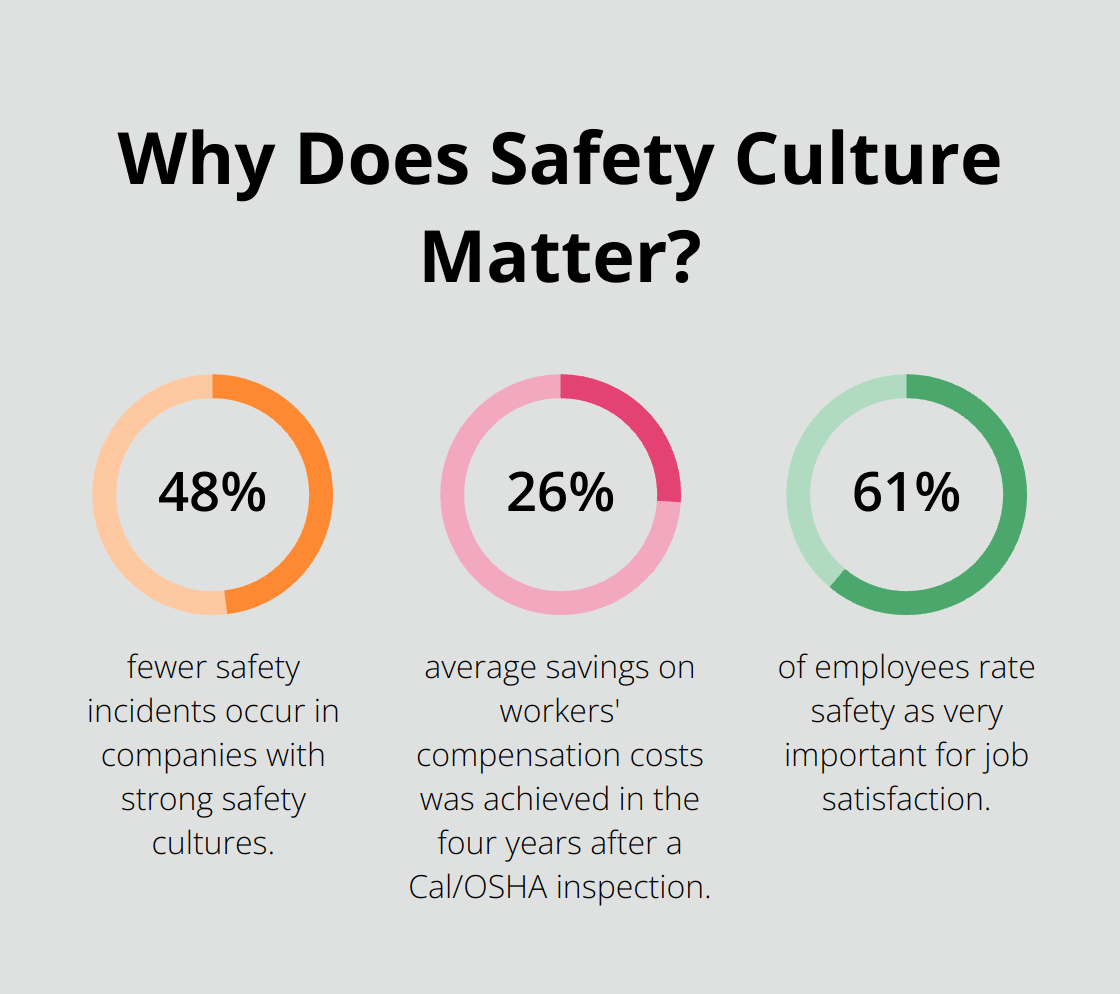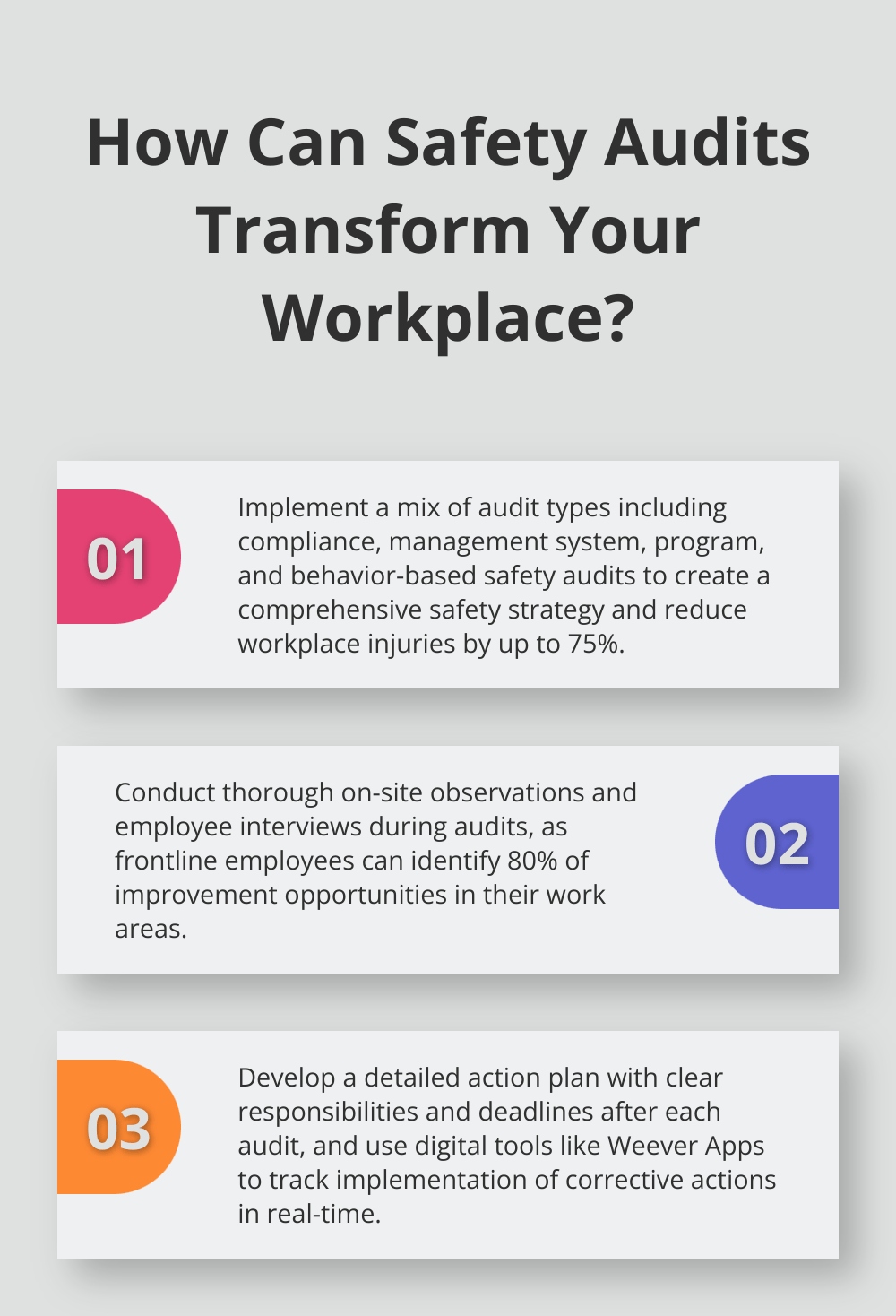Essential Health and Safety Audits for the Workplace
At Weever Apps, we understand the critical role of health and safety audits in the workplace. These audits are essential tools for maintaining a safe work environment and ensuring compliance with regulations.
Regular audits help identify potential hazards, assess risks, and implement necessary improvements. In this post, we’ll explore the different types of health and safety audits and provide practical tips for conducting them effectively.
What Are the Main Types of Health and Safety Audits?
Health and safety audits come in various forms, each serving a specific purpose in maintaining workplace safety. Different audit types can significantly impact an organization’s safety culture. Let’s explore the four main types of health and safety audits and their unique benefits.
Compliance Audits: Ensuring Regulatory Adherence
Compliance audits form the backbone of workplace safety programs. These audits focus on verifying that an organization meets all relevant health and safety regulations. Workplaces that establish an effective safety and health management system can reduce their workplace injury and illness costs by 20 to 40 percent. Compliance audits help achieve this by systematically reviewing policies, procedures, and practices against regulatory standards.
Management System Audits: Evaluating Overall Safety Framework
Management system audits take a broader view, assessing the effectiveness of an organization’s entire safety management system. These audits examine how well safety policies integrate into daily operations, from top-level management decisions to frontline worker practices. A study by the National Safety Council found that companies with strong safety management systems experienced 64% fewer safety incidents compared to those without.
Program Audits: Assessing Specific Safety Initiatives
Program audits focus on particular safety programs or initiatives within an organization. For example, a company might conduct a program audit on its fall protection measures or hazardous material handling procedures. These targeted audits allow for an in-depth examination of specific areas of concern, helping to identify gaps and improve focused safety efforts.
Behavior-Based Safety Audits: Focusing on Employee Actions
Behavior-based safety audits shift the focus to individual employee actions and decisions. These audits observe and analyze how workers perform their tasks in real-time, identifying both safe and at-risk behaviors. A report by the Cambridge Center for Behavioral Studies showed that companies implementing behavior-based safety programs saw a 40-75% reduction in injury rates within the first year.

Understanding and implementing these different types of health and safety audits creates a comprehensive safety strategy. Each audit type offers unique insights and benefits, contributing to a safer, more productive workplace. The key to effective auditing lies in consistency and follow-through – it’s not just about conducting the audit, but acting on the findings to drive continuous improvement.
Now that we’ve covered the main types of health and safety audits, let’s explore how to conduct these audits effectively to maximize their impact on workplace safety.
How to Conduct Effective Health and Safety Audits
Conducting effective health and safety audits is essential for maintaining a safe workplace. This guide provides practical steps to execute impactful health and safety audits.
Plan Your Audit
Define the scope and objectives of your audit clearly. Decide whether to focus on compliance, behavior, or specific programs. Set realistic timelines and assemble a qualified audit team. The American Society of Safety Professionals recommends auditors have a minimum of three years of relevant experience in the industry being audited.
Gather Meaningful Data
Data collection forms the core of any audit. Use a mix of methods to get a comprehensive view:
-
Document Review: Examine safety policies, incident reports, and training records. (Businesses that partner with OSHA through VPP have 50 percent fewer lost workday injuries.)
-
On-site Observations: Watch work processes in action. Look for both safe practices and potential hazards.
-
Employee Interviews: Talk to workers at all levels. Their insights provide valuable information. A Harvard Business Review study found that frontline employees spot 80% of improvement opportunities in their work areas.
-
Safety Walkthroughs: Conduct thorough inspections of the physical workspace. Use checklists to ensure consistency.
Analyze and Report Findings
After data collection, analyze and report your findings. Be specific and actionable in your recommendations. Prioritize issues based on risk level and potential impact. (The Bureau of Labor Statistics reports that slips, trips, and falls account for 27% of nonfatal occupational injuries.)

Create a clear, concise report that outlines:
-
Key findings
-
Areas of non-compliance
-
Recommended corrective actions
-
Timelines for implementation
Implement Follow-up Actions
The audit is just the beginning. The real value comes from acting on the findings. Develop a detailed action plan with clear responsibilities and deadlines. The Occupational Safety and Health Administration (OSHA) recommends reviewing and updating your action plan at least annually.
Monitor progress regularly. Use digital tools to track implementation of corrective actions. Platforms like Weever Apps allow real-time tracking of safety improvements across teams.
Effective audits require an ongoing process, not a one-time event. These steps and the right tools can significantly enhance your workplace safety culture and reduce incidents. The next section will explore the numerous benefits that regular health and safety audits bring to organizations.
Why Regular Health and Safety Audits Matter
Regular health and safety audits provide powerful tools for creating safer, more productive workplaces. These audits offer tangible benefits that transform organizations. Let’s explore the key advantages of consistent auditing practices.
A Proactive Safety Culture
Health and safety audits foster a culture where safety becomes everyone’s responsibility. The National Safety Council reports that companies with strong safety cultures experience up to 48% fewer safety incidents. This shift from reactive to proactive safety management reduces workplace accidents and injuries significantly.
Substantial Cost Savings
Regular health and safety audits can lead to significant cost savings. A study showed a 9.4% drop in injury claims and a 26% average savings on workers’ compensation costs in the four years after a Cal/OSHA inspection. These savings result from reduced workers’ compensation costs, decreased downtime, and improved productivity.
Regulatory Compliance
Compliance with health and safety regulations remains non-negotiable. Regular audits help organizations stay ahead of changing laws and avoid costly penalties. Thorough audits allow companies to identify and address potential compliance issues before they result in citations or legal action.
Enhanced Employee Engagement
Regular safety audits demonstrate a company’s commitment to employee well-being. This commitment increases job satisfaction and loyalty. A study by the Society for Human Resource Management found that 61% of employees rate safety as very important for job satisfaction. Engaged employees tend to be more productive and less likely to leave the company.
Continuous Improvement
Health and safety audits provide valuable data for continuous improvement. They highlight areas that need attention and help prioritize safety initiatives. This data-driven approach ensures that safety efforts focus on the most critical areas.

Final Thoughts
Health and safety audits in the workplace provide essential tools for creating safer, more productive environments. We explored four key types of audits: compliance audits, management system audits, program audits, and behavior-based safety audits. Each type serves a unique purpose in maintaining and improving workplace safety.

Consistent auditing practices prove crucial for long-term success. Regular audits help organizations stay ahead of potential hazards, ensure regulatory compliance, and foster a proactive safety culture. Organizations that prioritize audits often see reduced incident rates, lower costs associated with workplace injuries, and increased employee engagement (these benefits contribute to a more efficient and productive work environment).
Implementing a robust auditing program requires dedication and the right tools. At Weever Apps, we offer a Connected Worker platform that streamlines the auditing process, making it easier for organizations to conduct regular health and safety audits. Our platform includes features like automated workflows, real-time dashboards, and digital forms, all designed to enhance safety programs and boost operational efficiency.